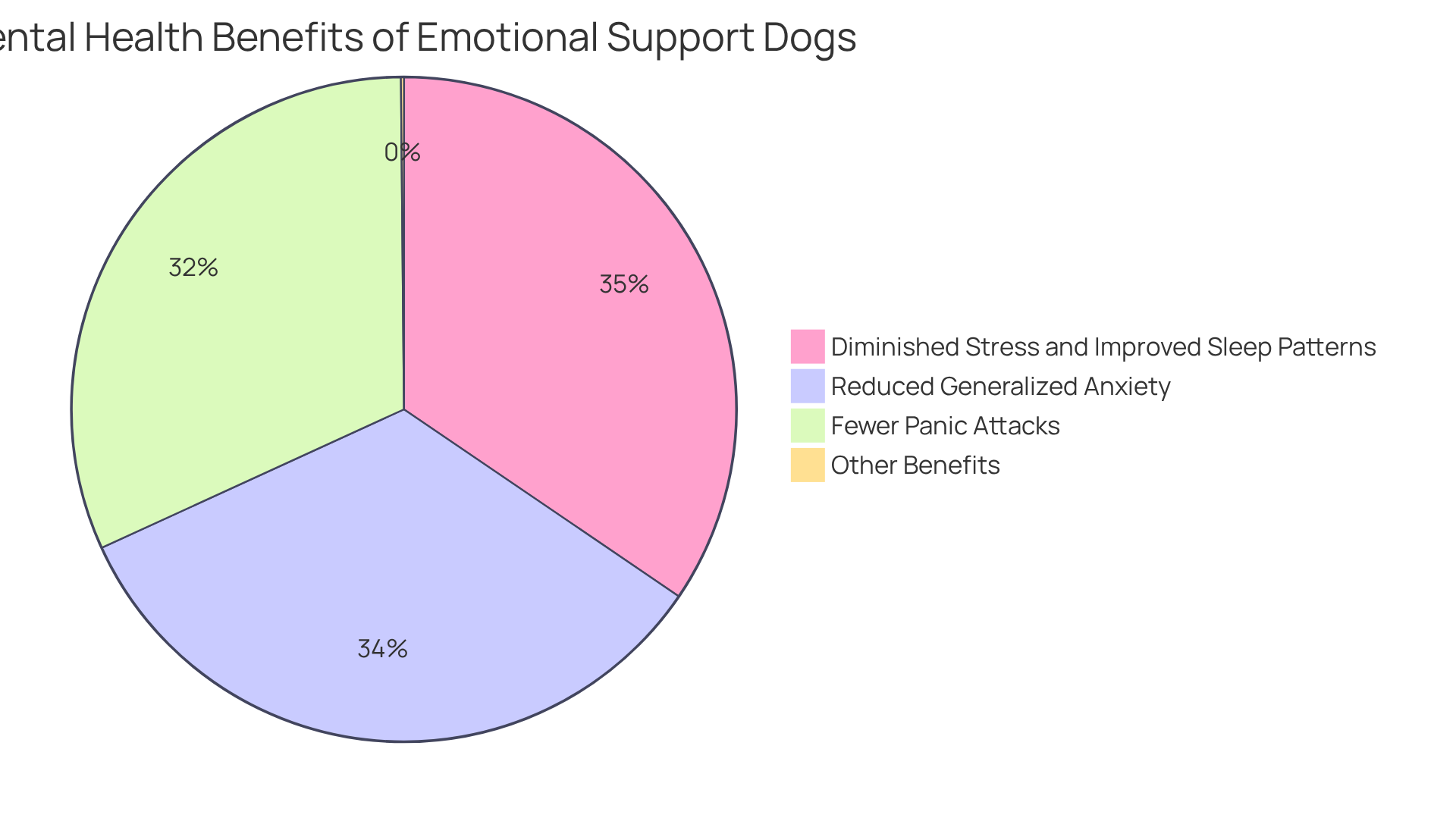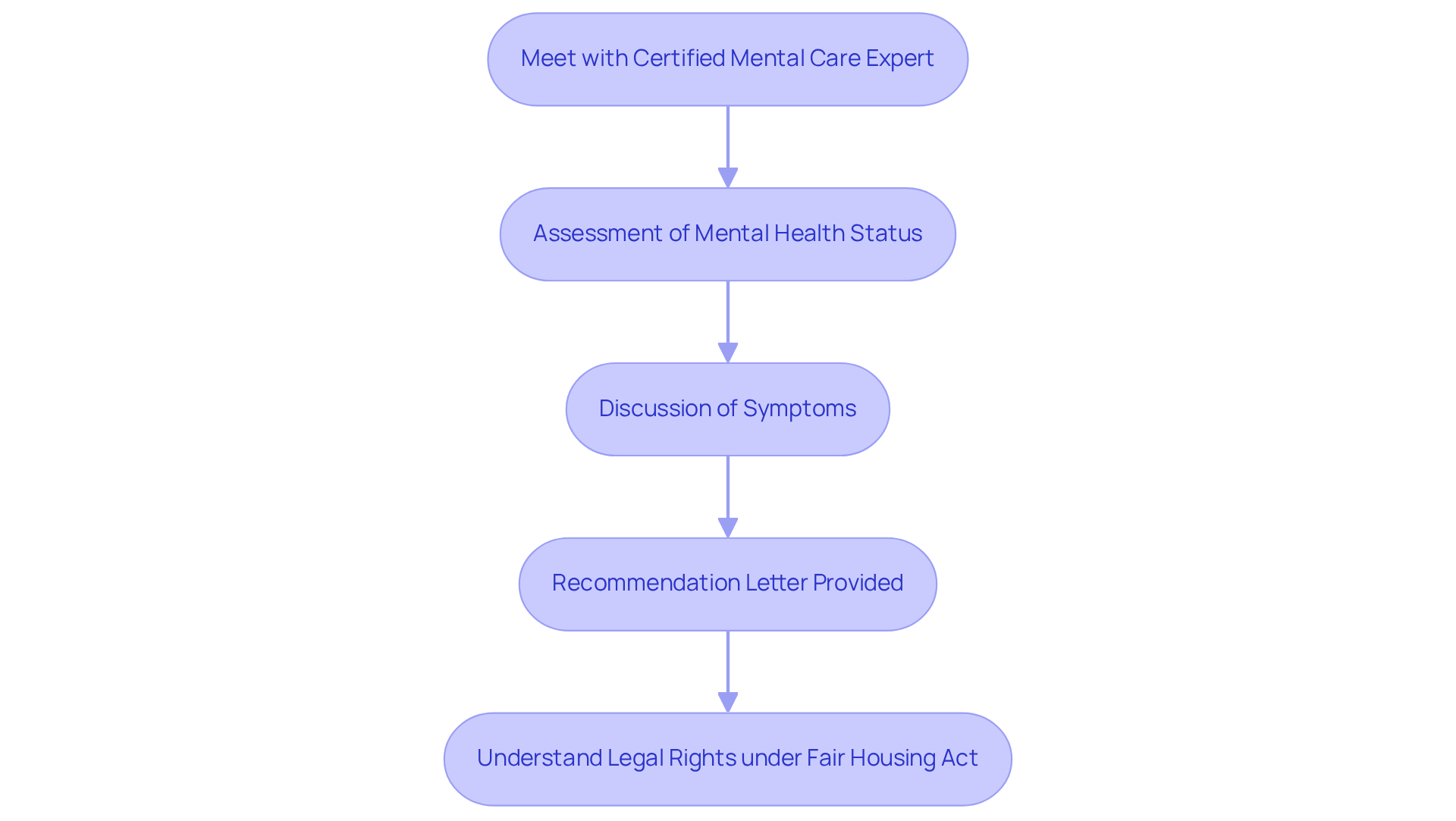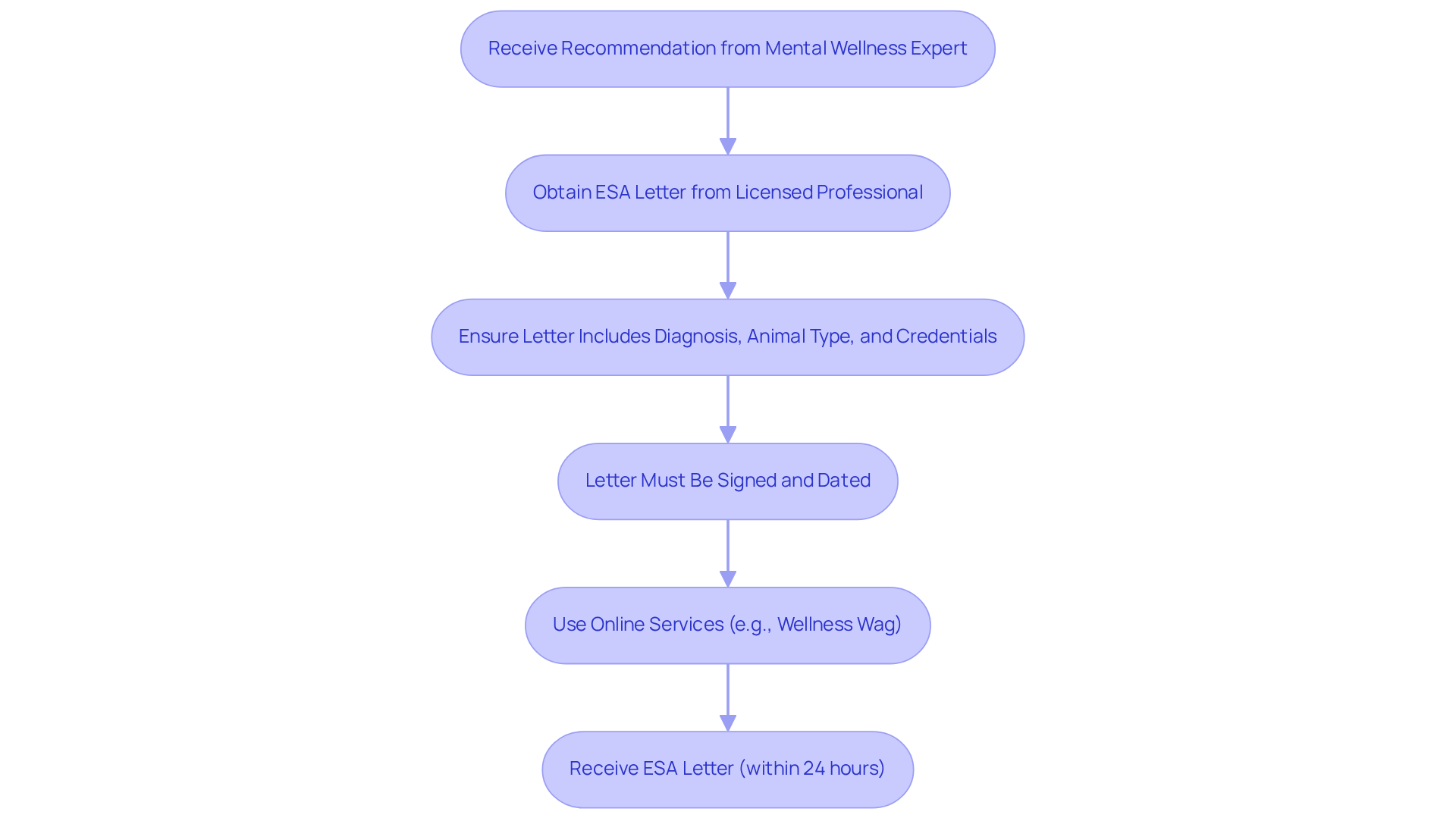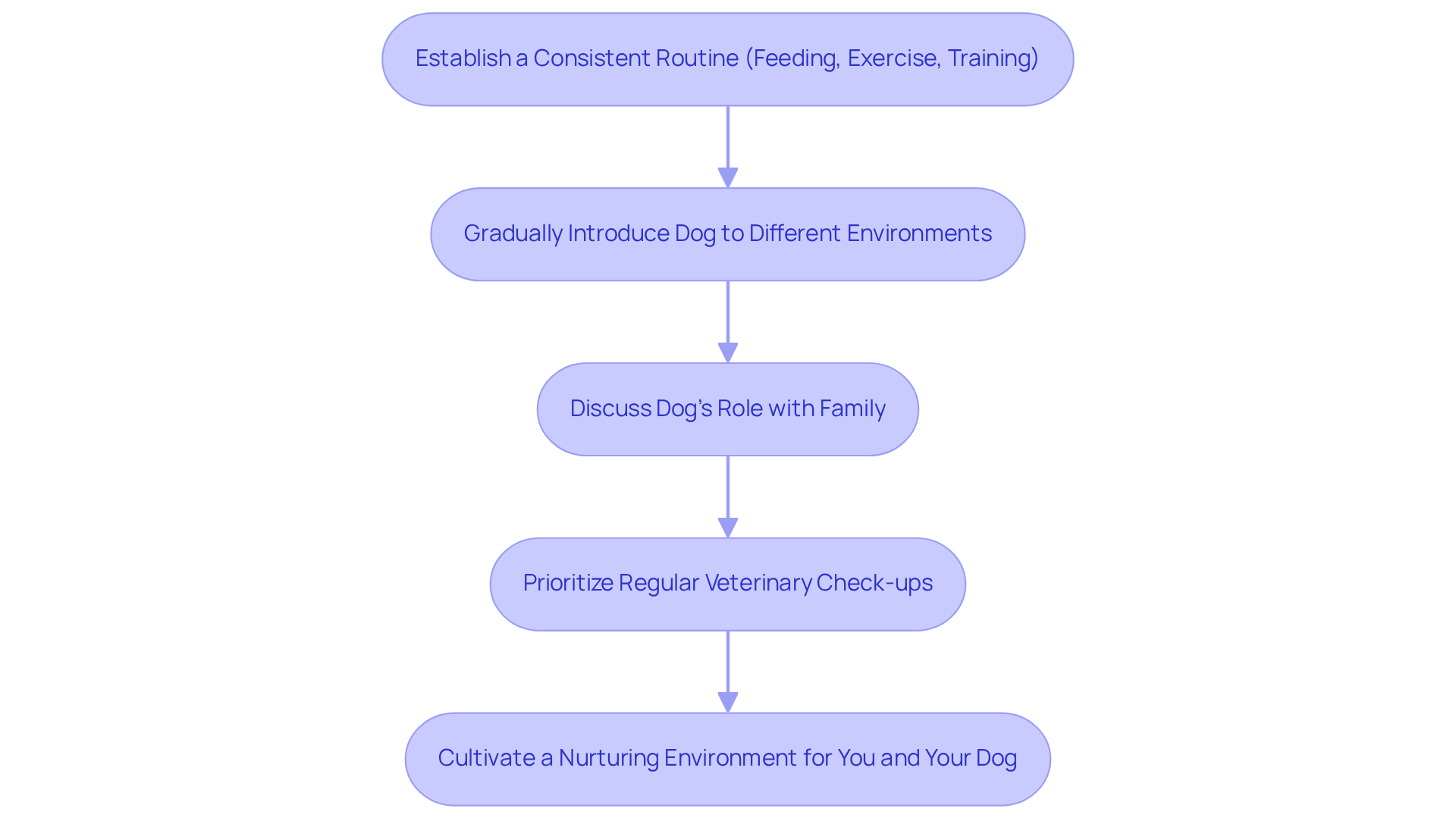

4 Steps for Getting an Emotional Support Dog Today
by Lena Park
Last updated: July 11, 2025
Verified and Approved by:
Angela Morris,
MSW, LCSW
Fact Checked

Overview
The article outlines a four-step process for obtaining an emotional support dog, beginning with meeting with a mental health expert. This crucial first step acknowledges the emotional struggles many individuals face, offering a compassionate path forward.
Following this, obtaining a recommendation letter serves as a supportive solution, reinforcing the importance of structured assistance in enhancing mental health.
Integrating the dog into daily life is the final step, emphasizing the profound benefits these animals can bring, such as reduced anxiety and improved overall well-being.
Each step is supported by evidence of the mental health benefits provided by emotional support dogs, underlining the significance of structured support in fostering emotional resilience.
The journey toward finding an emotional support dog is not just about the animal; it’s about embracing a nurturing relationship that can profoundly impact one’s mental health and well-being.
Introduction
Navigating mental health challenges can often feel isolating. For many, the companionship of an emotional support dog (ESD) offers a beacon of hope. These animals provide not only comfort but also a tangible way to alleviate symptoms of anxiety, depression, and PTSD. As our understanding of mental health evolves, so does the recognition of ESDs as vital partners in healing.
Yet, for those seeking to integrate an emotional support dog into their lives, the journey can be filled with questions about:
- Eligibility
- Legal rights
- The process of obtaining the necessary documentation
What steps must be taken to ensure that both the individual and their new furry friend can thrive together? This exploration is not just about the logistics; it’s about the profound emotional support that an ESD can bring into one’s life.
Define Emotional Support Dogs and Their Role
Support Dogs (ESDs) serve as vital companions for those navigating the complexities of psychological challenges, especially when getting an emotional support dog is considered. While service animals are specifically trained to assist individuals with disabilities and enjoy full public access rights under the Americans with Disabilities Act (ADA), ESDs primarily offer companionship and emotional stability. Their presence can profoundly alleviate symptoms of anxiety, depression, PTSD, and various mental health conditions, providing unconditional love and support.
Have you ever felt the weight of anxiety or depression? Research reveals that:
- 94.4% of individuals with ESDs experience reduced generalized anxiety.
- 96.80% report diminished stress and improved sleep patterns.
- 88.89% of ESD owners report experiencing fewer panic attacks.
Understanding the distinction between ESDs and service animals is crucial; it clarifies the expectations and legal protections associated with getting an emotional support dog, including rights under the Fair Housing Act. Though there is no legal requirement for service dogs to be certified or registered, obtaining certification can lend credibility and ensure that the service dog meets specific standards.
As of 2023, approximately 115,832 registered assistance animals are present in the U.S., with around 18% of pet owners having ESAs. This statistic highlights the growing recognition of ESAs as essential resources for mental well-being. Experts emphasize the significant role of getting an emotional support dog in enhancing psychological health, with many healthcare providers increasingly incorporating this practice into therapeutic approaches to complement traditional treatment.
ESDs not only provide companionship but also instill feelings of security and structure, both of which are critical components of mental wellness. Clients like Linda S. have shared their experiences, finding the process of applying for an ESA through Wellness Wag to be straightforward and professional. This underscores the warm and supportive environment that Wellness Wag fosters for individuals seeking assistance through animals.

Determine Eligibility for an Emotional Support Dog
To begin your journey towards qualifying for a companion dog, it’s essential to first meet with a certified mental care expert. This compassionate specialist will take the time to assess your mental health status and determine if an assistance animal could significantly enhance your well-being. Many individuals face emotional challenges such as anxiety, depression, and PTSD, and it’s important to recognize that assistance animals do not require formal training, which sets them apart from service animals.
During your consultation, you will have the opportunity to share your symptoms and how they affect your daily life. This is a safe space for you to express your feelings. If the professional concludes that an emotional assistance dog could help alleviate your symptoms, they will provide you with a recommendation letter. This letter is a vital step in the process, ensuring you receive the support you need.
Statistics reveal that over 84% of ESA owners report noticeable improvements in their mental well-being. This underscores the significance of this assessment in connecting individuals with the therapeutic support they deserve. Furthermore, it’s crucial to understand your legal rights under the Fair Housing Act, which permits individuals with verified ESAs to reside in pet-restricted housing. Remember, you are not alone in this journey; there is support available to help you thrive.

Obtain Your Emotional Support Animal Letter
After receiving a recommendation from your mental wellness expert, the next crucial step is getting an emotional support dog. This letter, crafted by a licensed mental wellness professional, should include essential details like your diagnosis, the type of animal recommended, and the professional’s credentials. It is important that the letter is signed and dated, as this documentation is necessary for your housing and travel accommodations.
Navigating the process can feel overwhelming, but online services like Wellness Wag are here to help. They simplify the journey, allowing you to obtain your ESA letter efficiently. In fact, Wellness Wag is committed to ensuring that clients receive their official ESA letters within 24 hours of approval. This quick turnaround is especially beneficial for those facing urgent housing or travel needs. Many individuals report receiving their letters within a few days when utilizing streamlined online services, highlighting the accessibility of this vital support. Remember, therapeutic animals have a profound impact on enhancing mental health, with 76% of service animal owners noting improvements in their daily functioning.
As you pursue your ESA letter, ensure it contains all necessary components to comply with legal requirements. This proactive approach not only safeguards your rights under the Fair Housing Act and Air Carrier Access Act but also highlights the importance of getting an emotional support dog in your mental health journey. Your emotional well-being is paramount, and having the right support can make all the difference.

Integrate Your Emotional Support Dog into Your Life
Incorporating your support dog into your daily routine is essential for enhancing the therapeutic benefits they provide. Establishing a consistent routine is the first step, encompassing regular feeding, exercise, and training sessions. This structure not only supports your dog but also fosters a sense of stability for you, ultimately strengthening your resilience. Research shows that routine can significantly alleviate anxiety levels in both pets and their owners, nurturing a healthier bond.
Gradually introducing your dog to different environments is key. This exposure helps them feel secure and comfortable, which is vital for their emotional well-being. It’s also important to discuss your dog’s role and needs with family members or roommates, ensuring everyone understands the care involved.
Moreover, prioritizing your dog’s well-being through regular veterinary check-ups and proper care is crucial. A well-cared-for dog is more likely to provide effective psychological support. For instance, many pet owners have shared that establishing a daily walking routine not only enhances their dog’s physical health but also encourages social interaction, thereby deepening their bond.
By following these best practices, you can cultivate a nurturing environment that strengthens your connection with your emotional support dog, which leads to improved mental health outcomes for both you and your dog. Additionally, understanding the process for obtaining Emotional Support Animal letters can facilitate housing access, ensuring that you and your dog can enjoy a supportive living space.

Conclusion
The journey towards acquiring an emotional support dog can be a deeply transformative experience, offering significant enhancements to mental well-being. Many individuals face emotional challenges that can feel overwhelming, and understanding the unique role of emotional support dogs is a vital step in taking proactive measures to improve quality of life. This guide has illuminated essential aspects of obtaining an emotional support dog, from defining their purpose to integrating them into daily routines.
- Consulting with a certified mental health professional is crucial in assessing eligibility for an emotional support animal.
- Obtaining a legitimate ESA letter can be a supportive solution, providing the necessary documentation to ensure access to these healing companions.
- Establishing a nurturing environment for the emotional support dog is equally important, as it fosters a loving relationship that can lead to healing and stability.
- Statistics reveal the profound impact these animals can have on mental health, with many owners sharing experiences of reduced anxiety and improved daily functioning.
While the process may seem daunting, resources like Wellness Wag simplify the journey, ensuring individuals receive the support they need in a timely manner. Embracing the companionship of an emotional support dog is not merely about having a pet; it is about fostering a relationship that nurtures emotional growth and stability.
For those struggling with mental health issues, taking the steps outlined in this article can pave the way for a more fulfilling life. The support of an emotional support dog can be a powerful ally in overcoming challenges, encouraging individuals to seek the help they deserve and to embrace the love and comfort that these remarkable animals provide. Remember, you are not alone on this journey; support is available, and taking the first step can lead to a brighter, more hopeful future.
Frequently Asked Questions
What are Emotional Support Dogs (ESDs)?
Emotional Support Dogs (ESDs) are companions that provide emotional stability and support to individuals facing psychological challenges, such as anxiety, depression, and PTSD.
How do ESDs differ from service animals?
While service animals are specifically trained to assist individuals with disabilities and have full public access rights under the Americans with Disabilities Act (ADA), ESDs primarily offer companionship and emotional support without the same legal access rights.
What benefits do individuals experience from having an ESD?
Research indicates that 94.4% of individuals with ESDs experience reduced generalized anxiety, 96.80% report diminished stress and improved sleep patterns, and 88.89% experience fewer panic attacks.
Are there legal protections for ESDs?
Yes, ESDs are protected under the Fair Housing Act, which allows individuals to have their emotional support animals in housing situations that may otherwise restrict pets.
Is certification or registration required for ESDs?
There is no legal requirement for ESDs to be certified or registered, but obtaining certification can enhance credibility and ensure that the dog meets specific standards.
How many registered assistance animals are there in the U.S.?
As of 2023, there are approximately 115,832 registered assistance animals in the U.S., with around 18% of pet owners having Emotional Support Animals (ESAs).
How are ESDs incorporated into therapeutic approaches?
Many healthcare providers are increasingly including the practice of getting an emotional support dog as part of therapeutic approaches to complement traditional treatment for mental health issues.
What experiences do clients have when applying for an ESD?
Clients, such as Linda S., have reported that the process of applying for an ESA through organizations like Wellness Wag is straightforward and professional, highlighting a supportive environment for individuals seeking assistance through animals.
Certify Your Emotional Support Animal Today

Why You Can Rely on Us?
At Wellness Wag, we believe your pet deserves care rooted in both science and compassion. Each article is carefully researched, written in clear language for pet owners, and then reviewed by qualified professionals to ensure the information is evidence-based, current, and practical for real-life care. Our goal is to help you feel confident in making informed decisions about your pet’s health and well-being.
Reviewed by
Angela Morris, MSW, LCSW
Angela is a licensed clinical social worker with 20 years of experience in patient advocacy and community mental health. She has assisted numerous clients with ESA evaluations and brings a deep understanding of disability accommodations, ensuring that all information is accurate, supportive, and practical.

Written by :
Lena Park
Last Updated :
July 11, 2025












